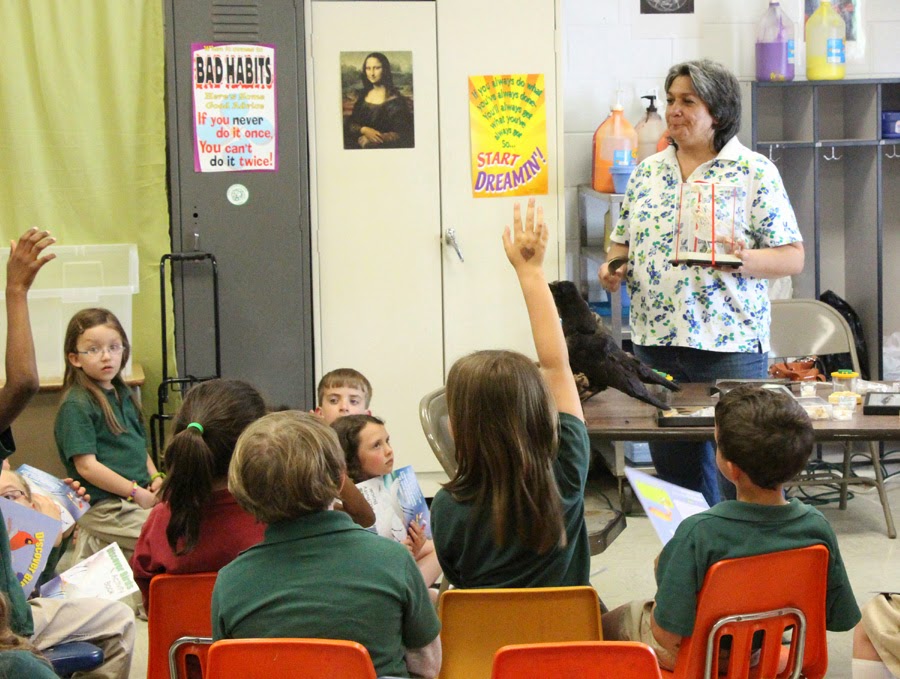 April 30th, the Discover Birds Program visited First Lutheran School in Knoxville, Tennessee, to introduce forty students to the amazing world of birds in their own school yard!
April 30th, the Discover Birds Program visited First Lutheran School in Knoxville, Tennessee, to introduce forty students to the amazing world of birds in their own school yard!The forty students were divided into small groups to circulate through the three parts of the program: a slide presentation, a close up bird treasures experience, and an outdoor bird walk. Students learned how to find the birds in their school yard and how to recognize them.
Above, students and volunteers gather in the school yard to begin their bird walk. Each of the students received a Waterford Press pocket guide to Tennessee Birds to carry on their bird walk to help them identify birds. They also could find birds they often see in their own yards.
Above, volunteer Doug Schneeberger scans for bird movement, while students get familiar with the birds on their guide. Students are taught how to spot a bird by watching for movement and listening.
The Discover Birds volunteers also shared binoculars and bird telescopes with the students giving them a special experience in viewing birds. Jerry Ledbetter, below, was able to find several bird nests that students could view through the scope.
Birds seldom are still for long, so adjustments to the scope were made frequently.Inside the school, volunteer Billie Cantwell, introduces the students to birds with a slide show, showing how their beaks, legs and feet relate to the types of food they eat. The slides also showed nests and the many sizes, shapes and colors of our world's birds.
Students were excited to already know some of the birds shown in the slides, such as the Ruby-throated hummingbird. Many also recognized the Northern Mockingbird and knew that the mockingbird is Tennessee's state bird.
In another room, volunteer and naturalist, Paula Schneeberger, showed students bird treasures including talons, feathers, nests and other types of bird items that could be passed around and seen close up by the students.
Below, students examine the long shaft of a flight feather.
Students enjoyed viewing the world around them through binoculars, including trees, flowers and windows! Each time they practiced looking through the binoculars they become better skilled at bringing the binoculars up to their eyes to find the item they wanted to see. Birds will be next!
Volunteer, Marikay Waldvogel, above and below, shows students how to find birds through an application on her mobile phone which shows images of the bird and can also play the bird songs.
After the students identified a bird, Marikay showed them how to enter the bird in the eBird BirdLog, an application that enables the bird watcher to electronically record the birds seen on a website where bird records are kept.
Above and below, a student enters the information about a bird.
Below, students discuss the birds they've seen and find them in their pocket guide.
A student receives assistance with using the binoculars, below.
Chimney Swifts were the most active birds seen zooming and clicking over head. Other birds included Northern Cardinal, American Robin, European Starling, and Rock Doves (pigeons). The students also noticed House Sparrows flying in and out of a hole under a roof in a house across the street from the playground. They promised to keep an eye on it to see if the birds are nesting there!
All the students enjoyed the activities and were surprised to discover the number of different birds they could find around their school yard.
Each of the students received a Discover Birds Activity Book, compliments of the Knoxville Chapter of the Tennessee Ornithological Society. A big thank you to First Lutheran School for inviting us to bring the Discover Birds Program to their school!
A special thank you to Colin Leonard for providing the above images.
A special thanks, also, to Discover Birds volunteers, Billie Cantwell, Marikay Waldvogel, Robin Barrow, Paula Schneeberger, Jerry Ledbetter and Doug Schneeberger. For more information on the Discover Birds Program contact Billie Cantwell: bfcantwell@gmail.com.
Links and Resources:
Discover Birds Program
First Lutheran School
Waterford Press Naturalist Pocket Guides


















No comments:
Post a Comment